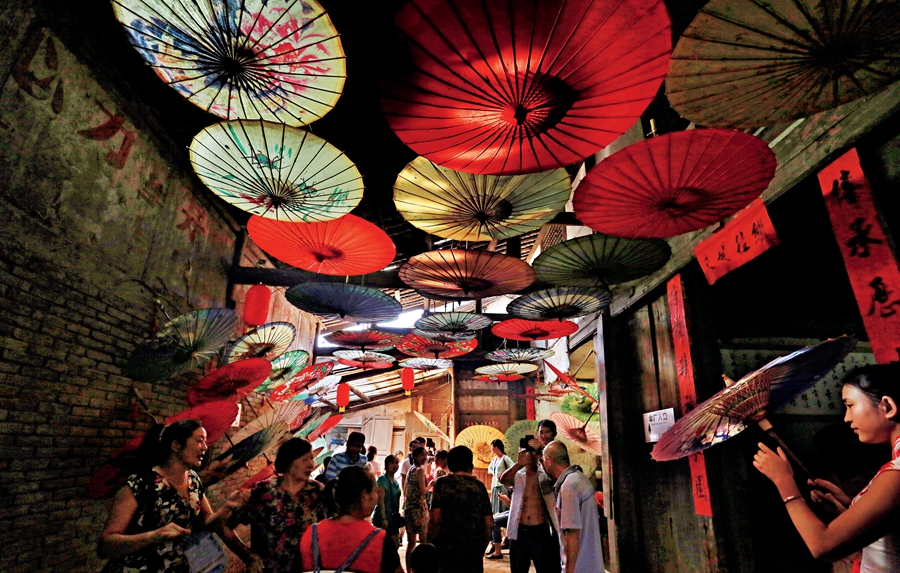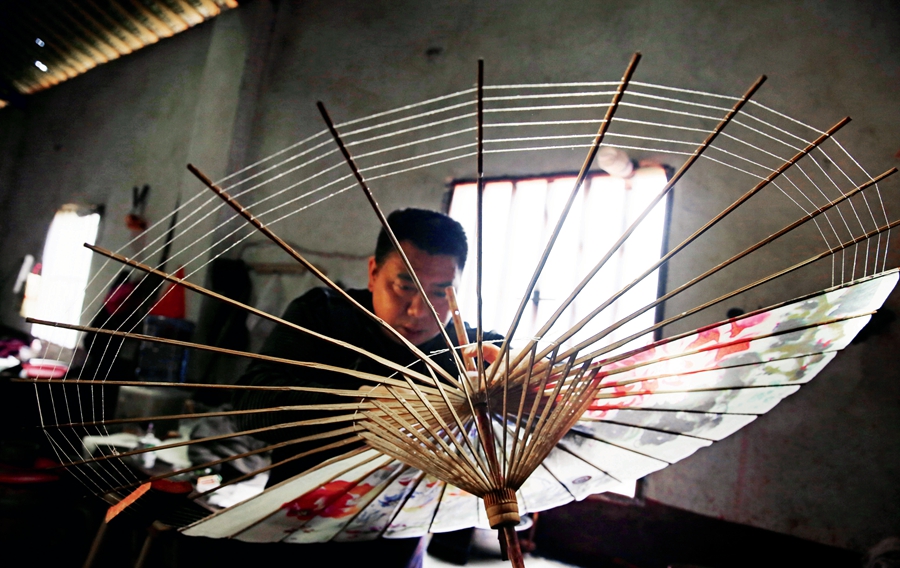ALONE holding an oil-paper umbrella, I wander along a long and solitary lane in the rain. Hoping to encounter a girl like a bouquet of lilacs, gnawed by anxiety and resentment,” quoted from A Lane in the Rain by Dai Wangshu, a famous Chinese poet in the 20th century.
Since the poem was published, oil-paper umbrella, lilacs, and a lane in the rain have become symbols of areas south of the Yangtze River featuring misty and rainy weather.
The oil-paper umbrella, with a history of over 1,000 years in China, used to be a water-proof accessory for daily use. It is named so because the umbrella’s surface is made of paper brushed with tung oil. In the 1880s, Fox Umbrellas introduced the steel umbrella frame, making the umbrella more convenient to use and achieved mass production. Most umbrellas today adopt the light steel ribs invented by Fox Umbrellas. By the last century, steel-ribbed umbrellas spread to China and gradually replaced the oil-paper umbrellas as they were easy to carry and priced much lower. The oil-paper umbrella thus became less used in daily life, instead turning into a decorative artifact.
History of the Oil-Paper Umbrella
There are different stories about the origin of the umbrella from China. The most popular one is related to Lu Ban (c.507-444 BC), a famous Chinese carpenter and builder. It is said that once he travelled with his younger sister to the West Lake in Hangzhou City. When it started raining, the sister said: “Let’s have a competition – whoever comes up with an idea before sunrise tomorrow to enable us to travel to the West Lake in the rain will be the winner.” Lu Ban thought it is easy. He collected some tools and timber and spent the whole night building 10 pavilions around the lake. He was quite confident about his efforts. However, the next morning, when Lu Ban was bragging about his achievements, his sister held a contraption in her hands, which could be opened into a round shape, resembling the roof of the pavilions made by Lu Ban. Lu Ban felt amazed by it. He found the item made of silk fabric and bamboo strips could also be closed into a cane and opened as a cone. It was light, portable, and beautiful. He conceded defeat. “Your portable ‘pavilion’ can shelter us from rain and it is easy to carry,” said Lu Ban. And thus, the umbrella was invented. Later when paper was invented, people used much cheaper paper to replace silk fabric, reducing the umbrella’s cost. To make the umbrella water-proof, people brushed tung oil across the surface. That was how the oil-paper umbrella was invented.

The oil-paper umbrella made in Luzhou City has a long history and been included into the list of national intangible cultural heritage since 2008.
The Tang Dynasty (618-907) saw increasing exchanges between China and other nations. The oil-paper umbrella was introduced to neighboring Asian countries and regions such as Japan, Korea, Vietnam, Thailand, and Laos, where it gained different names and developed different styles according to local culture and customs. For example, the oil-paper umbrella in Japanese culture is often associated with geisha, traditional dance, and tea ceremonies.
Oil-Paper Umbrella in Luzhou
In the past, the shops making oil-paper umbrellas were everywhere around the country. By the 1970s, oil-paper umbrellas were still used by some Chinese families. However, in the 1980s, the mass-produced nylon umbrella supported by metal ribs gradually replaced the hand-made oil-paper umbrella. Since the production of traditional oil-paper umbrellas requires skilled, time-consuming manual labor, resulting in higher costs, not many are involved in production nowadays. Today only a few places in China still produce such umbrellas and Fenshuiling Town of Luzhou City, Sichuan Province, is one of them.
Luzhou City sits in a transitional area between Sichuan Basin and the Yunnan-Guizhou Plateau, and abounds in rainfall and bamboo trees. The city has an illustrious history of over 400 years producing oil-paper umbrellas. In the 1940s, there were still over 100 factories making oil-paper umbrellas, with more than 10,000 people engaged in the profession. In the 1990s, the number of both factories and employees decreased sharply. In the past decade, people have gradually recherished the history and culture of oil-paper umbrella. As there is increasing number of people who like traditional umbrellas, its production in Luzhou has seen rejuvenation.
The typical color of the Luzhou-style oil-paper umbrella is red. To make such an oil-paper umbrella, the makers need to choose tortoise-shell bamboo (Phyllostachys edulis) which features good resilience. The bamboo needs to be treated in advance to prevent mold and damage by worms. A special cotton paper with high tensile strength is chosen for making the umbrella cover, which is painted with patterns such as flowers, birds, human figures, mountains, and rivers. The final step is to spread the tung oil evenly across the umbrella surface. Such oil-paper umbrella is very durable: it won’t crack, discolor, and become out of shape under blazing sun or heavy rain; it can be opened and closed for at least 3,000 times; its surface won’t separate from the ribs even if it is soaked in water for 24 hours. In addition, it can block harmful ultraviolet rays.
The traditional craft of making an oil-paper umbrella involves over 70 procedures of totally manual production. In general, it can be divided into five main steps: (1) Bamboo is selected. (2) The bamboo is crafted and soaked in water. It is then dried in the sun and assembled into a skeleton. (3) Paper is cut and glued onto the skeleton, and patterns are painted onto the umbrella. (4) The umbrella cover is oiled and exposed to sunlight. (5) Colorful cotton threads are used to fasten the skeleton and a handle is fixed. To make such an umbrella takes half a month even for an experienced craftsman. It also depends on the weather conditions. It will affect the formation of skeleton and smoothness of umbrella cover if the sunlight is too strong or if the moisture content of the air is too high due to constant drizzling.
The most representative Luzhou oil-paper umbrella is the one whose skeleton threaded with threads of various hues. Such craftsmanship is especially sophisticated, with more than 2,500 stitches, all done manually. Even in Luzhou, few craftsmen master this technique. Such well-crafted umbrellas were only offered to the imperial court in the past. When the umbrella is opened, those colorful threads form a pattern that resembles a blossoming peony, an aesthetically pleasing art that reflects the charm of traditional folk craftsmanship.
In 2008, the Luzhou oil-paper umbrella was included into the list of national intangible cultural heritage. In recent years, they have been sold to foreign countries and regions such as the U.K. and Japan.
Culture of the Oil-Paper Umbrella
The oil-paper umbrella has been an important symbol in traditional Chinese culture. The best-known story about the umbrella is the Legend of the White Snake, in which the main characters, namely Xu Xian and Bai Suzhen (a white snake nymph), become known to each other due to an oil-paper umbrella (Xu lent his umbrella to Bai when it was raining) and they gradually fell in love and were eventually married. Therefore, in Chinese literature, the oil-paper umbrella is often related to love stories. A typical picture about the areas south of the Yangtze River depicts a young man, a young woman, or a young couple holding an oil-paper umbrella meandering along a winding alley in drizzling rain, with houses of white walls and dark grey tiles standing on both sides.

Gluing the paper cover onto the skeleton requires a sophisticated technique, which is usually done by experienced craftsmen.
Because “oil” (in Chinese it pronounced as you) and “have” are homonyms, and “paper” and “child” are similar in pronounciation; also, as the character 伞 (umbrella) in original complex form contains “five people,” the oil-paper umbrella symbolizes a blessing for the family to have many children and grandchildren. The umbrella opens into a round shape, symbolizing a happy and complete life, so it is customary to include an oil-paper umbrella into dowries to the bride and such custom has been widely adopted in Hakka marriages in places such as Taiwan and some Southeast Asian countries.
In addition, the oil-paper umbrella also symbolizes romantic and faithful love. In the area inhabited by the Yao people, the umbrella has been used as an engagement present by the groom’s side. First the man proposes a marriage in the woman’s house. After acquiring the permission of the bride’s parents, he needs to send a representative to take a red oil-paper umbrella to the woman’s house and place it on the table above of which there is a shrine for ancestral tablets. If the bride is willing to marry him, she would take the umbrella from the table personally and stitch the umbrella with 12 triangle cotton decorations. The representative of the man’s family should bring the umbrella back as the proof of a successful engagement. If a divorce is made later, the husband must return the stitched triangle decorations back to the wife.
In the past, it was also a tradition for people who would travel far to take the imperial examinations to bring a red oil-paper umbrella in their backpack, so it is called Baofu (meaning backpack) umbrella. As “backpack” and “giving blessing” are homonyms in Chinese, bringing an oil-paper umbrella symbolizes the blessings for a safe journey and bright future for the candidate. People believe the red tung oil can ward off calamities, avoid evil spirits, and ensure safety. Today, some families in southeast coastal areas still hang the oil-paper umbrella on roof beam as a guardian of the house. The oil-paper umbrella is also widely used in ceremonies honoring ancestors. Because the emperors in ancient China were often under a big yellow umbrella when they went out of the palace, showing their supreme status, people use oil-paper umbrella to honor their ancestors in the hope that the deceased family members could enjoy an affluent life and a quick rebirth.
Although the red oil-paper umbrella is no longer a commonly used device for rainy days, it has never disappeared from people’s lives. Many places around China still keep the tradition of gifting a red oil-paper umbrella in celebration for birthdays, weddings, newborns, moving houses, and promotions at work.
(Compiled by China Today)